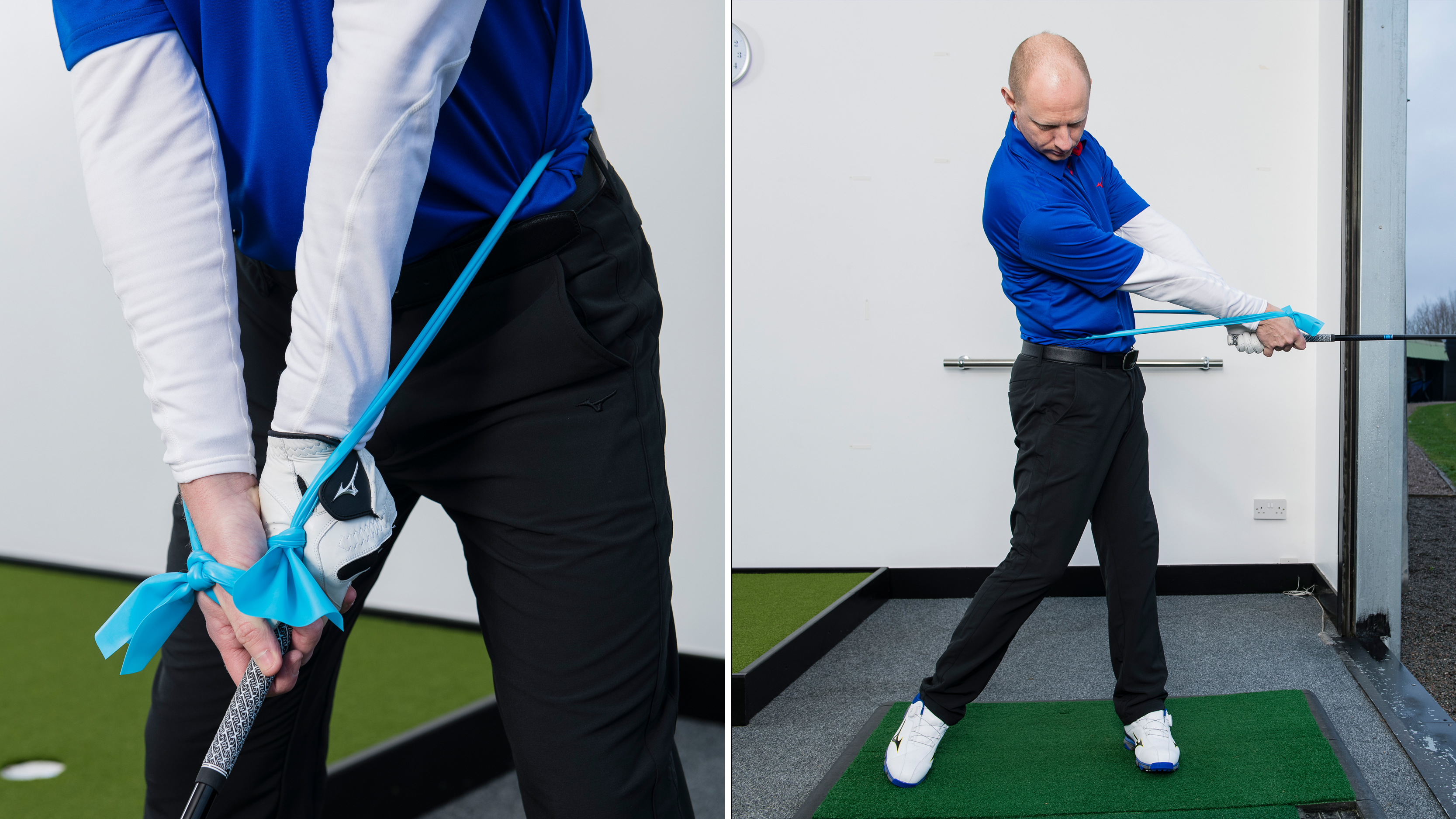10 Best Golf Drills Ever – Recommended By A Top PGA Pro
My 10 best golf drills will help amateurs of all abilities to improve their tee shots, strike the ball better, tidy up their short game and putt like a pro!


Every player should implement the best golf drills into their practice sessions, as they have the potential to supercharge your progress on the course.
Whether you are looking to achieve a centred strike with your driver, find the right ball position with hybrids or learn how to compress the golf ball with a better impact position, this article has something for you.
While there isn't necessarily a one size fits all approach to fixing the most common swing faults, I am going to use my extensive knowledge and years of experience as a PGA professional to help you play better golf...
1. Best Golf Drills: Ball-Striking
Nothing beats striking the ball well, out of the middle of the clubface, but sometimes it can be hard to know how close we are to 'middling' it. To get a better understanding, try spraying dry shampoo on the face of the club.
After you have hit the ball, the instant feedback provided by the mark left on the face will tell you everything you need to know. This is a great way to identify your focus moving forwards, whether that be learning how to stop toe strikes or getting a better understanding of golf shank causes.

Spraying the clubface with dry shampoo will help golfers identify their tendencies and try to address them
2. Slice Fix
Golfers who struggle with a slice could ease their woes with the help of a simple training aid... a swimming noodle. This relatively cheap tool can help you to understand the swing path you are trying to achieve, and provide visual feedback instantly.
Place the noodle on the floor in a position that mirrors the semi-circular movement of the golf swing (see image below), and take some slow practice swings.
Subscribe to the Golf Monthly newsletter to stay up to date with all the latest tour news, equipment news, reviews, head-to-heads and buyer’s guides from our team of experienced experts.
Feel how you move back in a circle. At the bottom, the club is moving down and coming through impact, before going on around in that circle to the finish.
Using this drill should improve your directional control, get your clubface more towards target and start to produce more solid strikes.

Setting up a swimming noodle as above will help you hone a better club path
3. Rhythm
Often, golfers think that swinging the club too fast is the reason their rhythm is out of whack, when in fact it's more to do with the order in which they change direction.
Ideally, we want a smooth rotation of the body, almost setting the club at the top of the backswing and adopting a rhythmical change of direction.
When you are ready in your address position, make a good 90 degree should turn with your left shoulder pointing downwards to the ball.
Take the club to the top of the backswing and smoothly rotate your lower body to initiate the downswing.
The lead hip and leg rotate to initiate this, so get used to the feeling that creates as this will help to generate a great downswing sequence.

Set the club at the top then work on transitioning smoothly into the downswing
4. Bunker Drill
This essential bunker drill will help you to understand how to get the ball out of the trap first time and how the club interacts with the sand.
Having a visual reference will help here, so draw a small rectangle in the sand around your golf ball. The idea is to remove all of the sand from inside your rectangle, with a clear entry point behind that ball.
Set-up with the ball a fraction ahead of centre, with slightly more weight on your front foot. Open the clubface, as this will allow you to start using the sole of the club more efficiently and will prevent the leading edge digging into the sand.
Take a swing and let your trail hand work down and underneath, throwing the sand nice and high towards the target.

Drawing a box around the ball and aim to remove the sand within is a great way to improve your bunker play
5. Strike The Match
You won't get the desired result with your long-irons without the correct speed through impact. But it's not all about swinging as fast as you can.
Learning how to compress the golf ball is far more important. As the club comes into impact, imagine yourself striking a match, imagine that same sound.
A sharp sound through impact means you've generated good speed, and crucially, at the right moment. This will help you improve launch, control and distance you hit your irons.

Imagine you're trying to light a match when hitting your irons
6. Tee Peg Drill
The is a difference between pitching and chipping, so before working on your short game, it pays to improve your understanding.
Designed to help your pitching, this drill is especially useful in getting rid of that nasty habit where the leading edge of the club digs down too much, one reason for those dreaded duff shots.
Instead, tee the ball up, take your normal set-up position and rehearse a few swings, visualising just clipping the ball up and away off the tee.
A shallower angle of attack will allow the sole of the club and the bounce angle to do the work. Breaking the tee is a no-no, as this means that the leading edge on your club is digging down.

This drill will help you shallow out your strike when chipping
7. Hybrid Drill
Even though the best golf hybrids are designed to be easy to hit, there’s a tendency for club golfers to get too shallow. In fact, you need more of a downward impact, which is where this drill will help.
Place a coin two or three inches in front of the ball and play your shot as you would do normally. If you miss the coin, it’s because the sole of the club is travelling upwards too soon – the likely result is a thin contact.
You want to hit the coin, as this tells you that you have the correct downward angle of attack. This will lead to purer and more consistent strikes, which is going to give you added distance too.

Placing a coin in front of the ball and trying to remove it after impact will improve the quality of your strikes
8. Putting Technique Drill
You could be the best player in the world at reading greens, but if you don’t start the ball on the right lines, the putts simply won’t drop.
This is why clubface alignment at impact is so crucial. In a bid to improve in this area, many people turn to their putting technique, but the answer is often much simpler.
The task here is clear: hit the ball along the metre rule into the hole.
This is one of my favourite putting drills that will help you to square the clubface at impact on a more consistent basis, while giving you visual feedback as to whether you’re pushing putts by opening the face, or pulling them by closing it.
In both cases, the ball will roll off the metre rule. If your speed is right, you’ll find the bottom of the cup.

Trying to hit a putt along a metre rule will enable you to control the putter face more
9. Club Face Control
You can practise this at home to improve your awareness of how the clubface is affected by the way you hold the club. Attach a pencil to the centre of your clubface with Blu Tack, as shown.
At address, the pencil should cover the alignment stick. From here, you’ll get an understanding of where your clubface is during the backswing and whether you tend to open it (pencil up), close it (pencil down) or keep it fairly neutral (pencil straight).
A strong golf grip with lots of knuckles showing on the top hand will encourage more of a closed clubface when you take the club back; a weak golf grip will see the pencil pointing more towards the sky.
Work on presenting the club back to target without any twisting or manipulation.

This visual aid will give you instant feedback on your clubface alignment
10. Topping Fix
Topping often comes as a result of trying to hit up on the ball. It’s a common fault in which you see the elbows separating and the wrists then acting to save the shot.
If you're guilty of this and want a drill on how to stop topping the golf ball, you've come to the right place. First, apply the resistance band as shown.
What I’m having to do is fight the resistance pulling my arms back towards my body. It helps you get used to the feeling of your arms extending as you go out and down towards the ball.
After a few swings, remove the band and you should find it’s far easier to get your arms extended.
Brush the ground with the sole and get that ‘whoosh’ sound. This will tell you that you’re extending your arms more and your chances of topping the ball will be greatly reduced.

Using a resistance band like this will help you stop topping the ball for good
How Long Should I Spend At The Driving Range?
Golf Monthly says:
The answer to that question depends on how long you have to practice, but 30 minutes to an hour is widely considered a perfect amount of time to embed new routines and movements while also seeing some progress.
Our best advice is to go with a plan, or an idea of what you want to work on. Rarely will you get anywhere by motoring through a whole bucket of balls aimlessly, so take some time to consider what you want to improve and perhaps use some of the drills outlined above to help you move in the right direction.
Not sure what to do at the range? Check out our expert guides on the best 30 minute driving range session and the ultimate 60 minute practice session constructed by a top tour professional.

Location: True Fit Golf Centre
Using different styles, teaching aids, technology and games to measure improvements, Ged is keen to make the learning process educational and fun. He's worked with a number of top local, national and international instructors, including Adrian Fryer and Jeff Ritter, one of the most prominent golf instructors in America. He's based at True Fit Golf Centre in Warrington, where he can be found coaching golfers of all abilities. He's also working hard on his own game with the aim of playing on the senior Tour (when the time comes).
Students learn best when...
They leave their baggage at the door; this way they will garner a clearer understanding of their issues and how they can
improve.
Advice for practice:
Don't go rogue! You will never improve if you don't practice how your coach has told you to.
Most common problem:
Too many golfers judge if they have done what you ask by the outcome, yet that will not always be what they want to see when making changes. Focus on the process and the outcome will take care of itself.
You must confirm your public display name before commenting
Please logout and then login again, you will then be prompted to enter your display name.